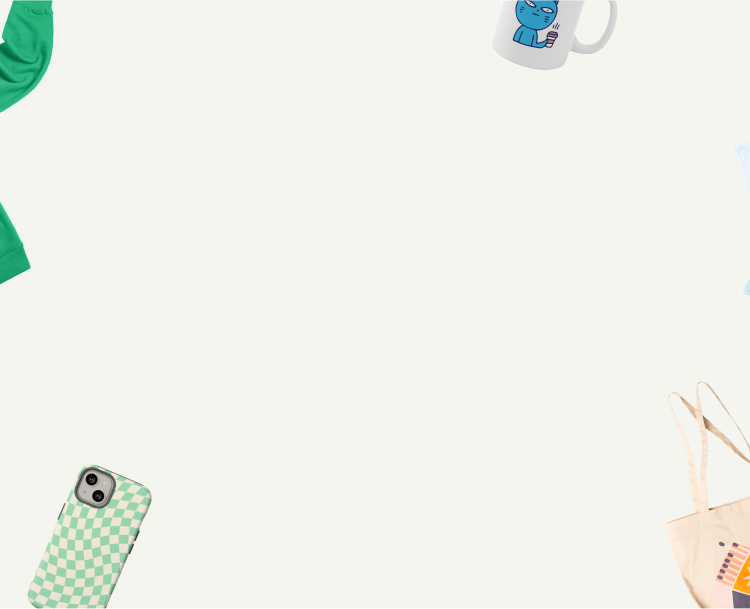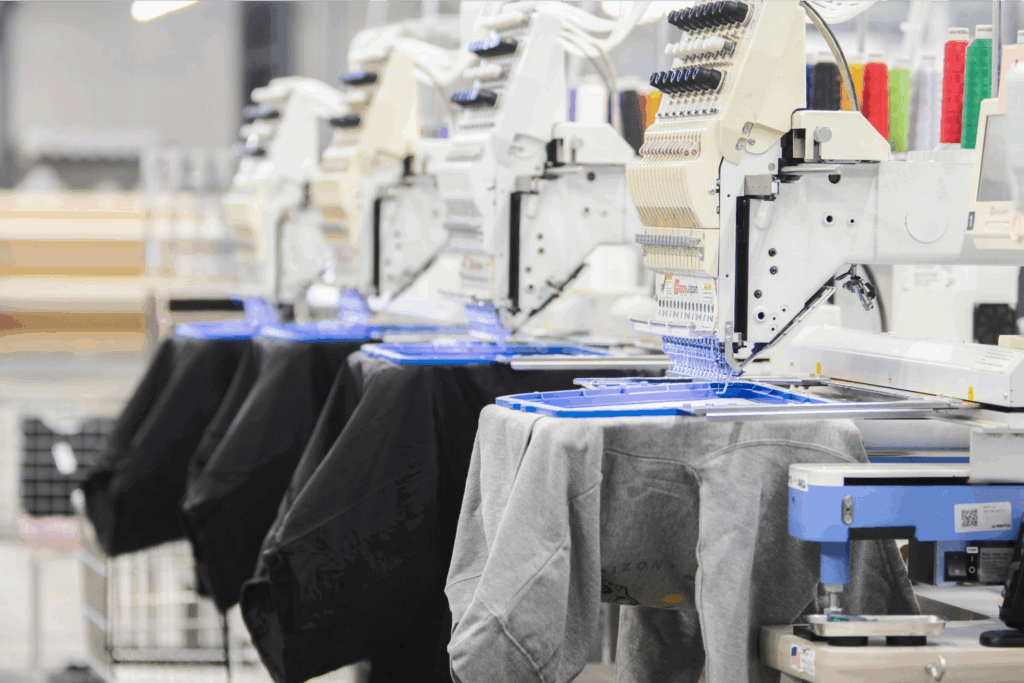Start a print-on-demand business today
You control the designs, the brand, the vision – but your pricing controls your profits.
In this guide, you’ll learn how to price print-on-demand products to beat competition – whether you’re launching your first online store or scaling up. We’ll cover how to calculate your production costs, choose the best pricing strategy, and use Printify’s tools to refine your prices for maximum profit margins and growth.
Print-on-demand pricing basics
Print-on-demand (POD) pricing isn’t like traditional retail.
You don’t buy stock up front or manage inventory. Instead, every product is made to order, which changes how you approach pricing.
Why is POD pricing unique?
Print on Demand is flexible and low-risk – but each item has higher production costs than bulk-manufactured goods.
That means success depends on understanding your total cost structure. Your pricing must do more than cover expenses involved – it must support your business goals, reflect your brand’s value, and stay competitive in your niche.
When you master that balance, POD pricing gives you freedom: no stock to manage, low startup risk, and the flexibility to scale without the financial strain.
Core elements of POD pricing

Every strong pricing model starts with a clear knowledge of what you’re paying for. These five components define your product’s total cost and determine your profit margins.
1. Base cost
The base cost is what your POD partner – like Printify – charges to make each product.
This price depends on:
- Product type, size, and material
- Printing technique (e.g., DTG, embroidery, sublimation)
- The Print Provider you choose
Printify’s Catalog shows real-time base costs across multiple providers, helping you compare and select the best option for your profit goals.
2. Fulfillment and shipping
Fulfillment covers the physical production and packaging process, while shipping costs depend on location, delivery speed, and method.
The two most popular options to handle shipping costs:
- Offer free shipping by including the shipping cost in your retail price
- List it separately to stay transparent
To offer competitive pricing, test both. For example, free shipping can boost conversion rates, but separate fees may keep prices flexible across regions.
3. Platform fees
Most eCommerce platforms charge monthly subscriptions, listing fees, or take a cut of each sale. These are part of your total cost.
4. Your markup
Your markup determines how much profit you make per sale. A good starting point is to add 30-50% on top of your total product cost. Adjust based on your niche, audience, and perceived value.
5. Taxes
Depending on where you sell, you might need to collect sales tax or VAT. Use your platform’s built-in tools where possible, but remember that you’re responsible for compliance.
Together, these components shape your pricing strategy. Knowing them lets you set profitable prices that work for you – not just your platform or provider.
Quick formula: How to calculate print-on-demand costs
To recap, here’s a simple way to calculate your total cost and profit margin:
Total cost = Base cost + Fulfillment and shipping + Platform fees + Taxes
Profit margin = (Retail price – Total cost) ÷ Retail price × 100
How to price print-on-demand products?

Start with competitor research
Before setting prices, study similar products and their pricing in your niche. Search for competitors on marketplaces like Etsy, eBay, or Shopify online stores. Note how popular POD businesses position themselves.
Competitive analysis helps you establish:
- How saturated is the market?
- Where does your offer fit?
- What are potential customers already paying?
Focus on sellers targeting the same audience and offering comparable product quality. Track:
- Retail price range for each product
- If they offer free shipping
- Design complexity and custom features
- Overall product quality and brand presentation
Your goal isn’t to copy or undercut prices. It’s to benchmark your competitor pricing so you know where to position yourself.
Undercutting isn’t always smart. If you price too low, you’ll shrink your profit margins and signal low quality. Too high without strong perceived value – you’ll price yourself out of the market. Instead, ask: What makes your product worth the price?
Start near the market average, then adjust your product price based on quality, audience, and goals.
Consider key price-shaping factors
Your product isn’t just a mug or a hoodie – it’s part of a brand.
That means your pricing should reflect more than just cost. Here are the most important factors that influence what customers are willing to pay:
- Product quality: Customers pay more for visibly higher-quality items. Don’t try to compete with mass-produced items if your materials, print, or designs are better.
- Niche markets: Smaller, passionate audiences often pay extra for unique designs or values that align with their identity. For example, an eco-conscious audience might pay more for sustainably sourced products, even if base costs are higher.
- Perceived value: Perceived value comes from your store design, product photography, packaging, and storytelling. The better the perceived value, the stronger your case for premium pricing.
- Customer preferences: Know how your target audience shops. Are they deal hunters or brand loyalists? Pricing must align with expectations.
- Average print-on-demand profit: Keep industry benchmarks in mind, but optimize for your own situation. A niche with lower volume might require a higher price per product to hit your revenue goals.
- Healthy profit margins: Even after accounting for fees and shipping, make sure you’re earning enough to reinvest and grow. Most successful POD businesses aim for 30-50% profit margins, depending on product category.
There’s no universal formula. Instead, build pricing around what makes your offer valuable – and how your ideal customer buys.
Select a pricing strategy

Now that you know your costs and market, choose a pricing strategy. There’s no one-size-fits-all solution – the best pricing model aligns with your brand, niche, and goals.
Here are the most common approaches:
- Cost-plus pricing
Add a fixed markup to your product cost, resulting in a healthy profit margin. It’s straightforward, reliable, and easy to calculate. However, it doesn’t take into account customer expectations or competitor positioning.
Use when: You’re starting out and want a clear, reliable structure.
- Value-based pricing
Price based on what your audience believes the product is worth. This strategy works when you have a strong brand identity and perceived value.
Use when: You’ve built brand loyalty or have designs that customers see as premium or exclusive.
- Competitive pricing
Set your product price close to or slightly below the market average. It helps you stay competitive in crowded markets while protecting your profit.
Use when: Entering a saturated niche or testing new designs where demand is high.
- Penetration pricing
Launch with lower prices to quickly gain market share, then raise prices once you’ve built trust and reviews. This approach can quickly increase sales performance and establish your brand in a new market.
Use when: You’re new and need traction quickly.
- Psychological pricing
Use prices that feel lower – e.g., set prices at $24.99 instead of $25. It’s a subtle tactic that improves conversion rates without affecting profits.
Use when: Competing in price-sensitive niches or running promotions.
- Dynamic and seasonal pricing
Adjust pricing based on demand, seasonality, or limited-time promotions. For example, raise prices during holidays when customers expect premium pricing, or lower them for clearance events.
Use when: You want flexibility and data-driven control over your product prices.
The best strategy often combines two or more approaches. For example, you might use value-based pricing year-round, then switch to penetration pricing to launch a new product line.
Refine pricing based on real data
Pricing isn’t static; it evolves with your brand and market. Revisit it regularly based on performance and insights.
- Track conversion rates
If visitors land on your page but never buy, it might signal a mismatch between price and perceived value. A small adjustment up or down can change conversion rates dramatically.
- Review your sales performance
Identify which products sell best and which lag behind. If a high-quality item isn’t moving, the final price isn’t aligned with your audience’s expectations.
- Use analytics tools
Use your eCommerce platform’s tools or Google Analytics to track behavior over time. Look for patterns: what happens when you raise prices or run a promo?
If you use Printify, adjust pricing directly in your My Products dashboard and sync updates to your store. Then track results through your eCommerce analytics or connected sales channel.
- Listen to customer feedback
Customer comments and reviews often reveal how people perceive your pricing. If buyers mention value or affordability, use that insight to adjust your strategy.
As your store matures, test new strategies:
- Bundle pricing to increase average order value.
- Tiered pricing for volume discounts.
- Time-sensitive offers to create urgency.
These minor, data-backed adjustments significantly increase profitability without hurting brand perception.
4 tips for the perfect print-on-demand pricing strategy

1. Emphasize perceived value
The better your product looks and feels, the more customers will pay for it. That doesn’t just mean high-quality printing – there’s also branding, lifestyle photography, product descriptions, and the overall ambiance of your store.
Your product page should signal value at every step. A clean layout, sharp mockups, thoughtful details, and a compelling narrative all grow perceived value.
If you’re charging higher prices, show your customers the why.
2. Price product categories strategically
Not all items in your print-on-demand store should follow the same pricing formula. Some categories, like premium hoodies or canvas prints, command higher prices due to the value of the materials or perceived exclusivity.
Others, like stickers or mugs, benefit from a lower price to drive volume or bundle sales. Look at your product cost, competitor pricing, and audience expectations for each category.
Use Printify’s Catalog to check base prices by category. Then decide whether to apply:
- A higher markup for premium items (e.g., apparel, canvas prints)
- A lower markup for low-cost, high-volume products (e.g., mugs, stickers)
This approach balances healthy profit margins across your store.
3. Run promotions and discounts strategically
Discounts increase sales performance, but too many harm your brand.
Instead of constant markdowns, focus on strategic promotions:
- Offer free shipping above a set order value to raise your average order value.
- Bundle complementary products to encourage multi-item purchases.
- Use limited-time discounts to drive urgency.
Avoid over-discounting – it trains customers to wait for sales and erodes perceived value.
4. Monitor performance and adjust
A great pricing strategy is never static. Keep an eye on your top sellers, test new price points, and listen to what your repeat customers say.
Use every sale, click, and comment as a signal. If one product consistently converts better at a slightly higher price, consider raising prices across similar listings.
Small tweaks backed by data often yield significant results.
Start a print-on-demand business with Printify

Printify is a leading print-on-demand platform that helps you design, create, and sell custom products with ease. Create a free Printify account to get started – no upfront investment or inventory management needed. Launch and scale your brand on your own terms.
Starting is simple:
- Pick a product – Explore 1,300 customizable items in our Catalog.
- Add your design – Upload artwork or create with our Product Creator.
- Set your prices – Apply your preferred pricing strategy.
- Connect your store – Use our integrations with top eCommerce sales channels.
- Publish and sell – Start earning from day one while our network handles fulfillment.
With Printify’s access to 80+ Print Providers worldwide, transparent base costs, and automated fulfillment, you can offer competitive pricing and beat the competition.
Whether you’re creating side income or launching your full-time hustle, Printify gives you the tools, products, and partners to make it happen.
FAQ
Analyze similar products in your niche – their retail price, product features, design quality, shipping options, and customer feedback.
If your designs or materials offer higher value, price above average. If you’re just entering the market or targeting price-sensitive potential customers, start with lower prices to gain traction.
Balance competitiveness with profitability by adding your design, shipping, and marketing costs before applying your target profit margin.
Successful print-on-demand sellers combine strategies.
- Value-based pricing reflects the buyer’s perception of your product’s worth.
- Cost-plus pricing ensures your base product cost and overhead are covered with a consistent markup.
- Psychological pricing (like $19.99 instead of $20) can boost sales.
- Competition-based pricing works in crowded markets.
- Bulk discounts and time-limited offers raise average order value and create urgency.
Test each approach and refine based on what drives the most sales.
Check each provider’s shipping price by location, speed, and product type – Printify lets you compare rates across suppliers in your dashboard.
Decide whether to include shipping in your retail price (free shipping) or list it separately for transparency.
Free shipping often boosts conversion rates, especially with order thresholds, but only if your pricing still covers production costs, fulfillment, and platform fees.
Always factor in international rates and choose a model that fits your audience and overall pricing strategy.
Focus on value. Use Printify to compare provider costs and identify where you can save without reducing quality. Highlight your product’s unique benefits and justify your price through brand experience and superior customer service.
Conclusion
Pricing is more than math; it’s strategy. The right approach helps you offer competitive pricing, build a strong brand, and scale your business sustainably.
As you refine your strategy, focus on three things:
- Understand all production costs behind your product.
- Build perceived value through design, storytelling, and quality.
- Continuously test, measure, and adjust to protect your profit margins.
With Printify, you have everything you need to make data-backed decisions and grow your print-on-demand business with confidence.












